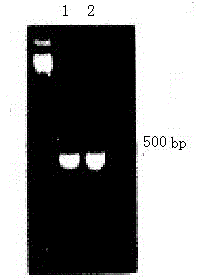Primer pair for Russian longhorn beetle larva cloning, and applications thereof
A technology of long beetle larvae and primer pairs, which is applied in the determination/inspection of microorganisms, biochemical equipment and methods, DNA/RNA fragments, etc., and can solve the problems of undescribed larval morphology, lack of larval isolation and identification data, and easily confused identification. , to achieve high specificity and stability
- Summary
- Abstract
- Description
- Claims
- Application Information
AI Technical Summary
Problems solved by technology
Method used
Image
Examples
Embodiment 1
[0015] Example 1: Preparation of the kit.
[0016] 1. Test material
[0017] The longicorn beetle specimens used were the specimens intercepted by the insect laboratories of Jiangsu Entry-Exit Inspection and Quarantine Bureau for many years. The source and collection time of the specimens are shown in Table 1. In addition, 28 beetle COI gene sequences registered in Genbank were selected for comparison, see Table 2.
[0018] Table 1 Name and source of experimental specimens
[0019]
[0020] Table 2 Genbank download sequence information
[0021]
[0022]
[0023] 2. Reagents
[0024] Contains Mg 2+ 10×PCRBuffer, 2.5mmol / L dNTPs, Taq DNA polymerase was purchased from Dalian Takara Company; DNAMarker and GoldView were purchased from Nanjing Shanggao Biotechnology Company; primers were synthesized by Shanghai GenScript Co., Ltd. Other reagents are imported or domestic analytical reagents.
[0025] 1. Design and synthesis of primers
[0026] According to the compl...
Embodiment 2
[0034] Embodiment 2: identification method
[0035] Follow the steps below:
[0036] (1) Extraction of total genomic DNA: GenMag animal tissue / cell genomic DNA extraction kit: soak the worm body in alcohol, select muscle tissue of appropriate size, wash 2-3 times with sterile water, drain the water, and The tissue was ground, and an appropriate amount of lysate and proteinase K was added, and the tissue was warmed at 55°C to completely lyse the tissue. Then add magnetic beads and buffer to make the DNA adsorb to the magnetic beads, use WashBuffer to remove impurities, after the removal of impurities, add a small amount of ElutionBuffer to dissolve the DNA to obtain a genomic DNA solution, and store at -20°C.
[0037] (3) PCR amplification: The PCR reaction system uses a 50 μl standard reaction system, which contains 10×PCRBuffer (Mg 2+ ) 5μl, dNTPs (2.5mmol / L) 4μl, Taq DNA polymerase 0.4 μl, cDNA template 2 μl, upstream and downstream primers 1 μl each, add ddH 2 O to make...
Embodiment 3
[0044] Embodiment 3: specificity experiment
[0045] Using the same method as in Example 2, the DNA of 28 kinds of beetles was extracted and used as a template to carry out PCR amplification with the designed primers. Using 1% agarose for gel electrophoresis, only a 481bp fragment was amplified from Russian longhorn beetle larvae (see figure 1 ), sequenced the PCR product of the pigeon fine ring positive disease material, compared it with the published sequence in GenBank, and applied the Mega5.0 software to analyze the COI gene sequence of longhorn beetle, and found that the conserved site was among the 481 sites 90, 391 mutation sites, 375 informative sites, and 16 self-descended sites. Considering the high degree of heterogeneity among different species of Russian longhorn beetle larvae, it can be shown that the amplified fragment is the Russian longhorn beetle larvae COI gene, while none of the other 28 species of longhorn beetles amplified fragments or bands, which indi...
PUM
 Login to View More
Login to View More Abstract
Description
Claims
Application Information
 Login to View More
Login to View More - R&D
- Intellectual Property
- Life Sciences
- Materials
- Tech Scout
- Unparalleled Data Quality
- Higher Quality Content
- 60% Fewer Hallucinations
Browse by: Latest US Patents, China's latest patents, Technical Efficacy Thesaurus, Application Domain, Technology Topic, Popular Technical Reports.
© 2025 PatSnap. All rights reserved.Legal|Privacy policy|Modern Slavery Act Transparency Statement|Sitemap|About US| Contact US: help@patsnap.com



